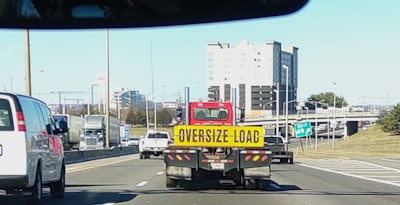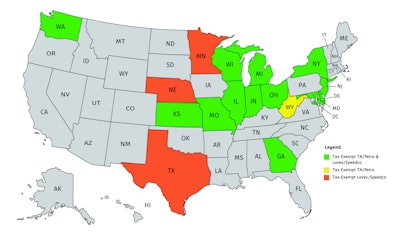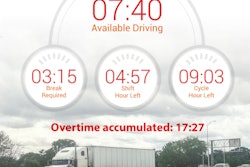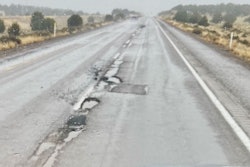
An online discussion -- about opportunities to avoid paying sales taxes on truck parts (for more on that, see below) -- recently got me thinking about what I’ll refer to as parasitic costs buried below the surface of our everyday behaviors and actions. Picture a vehicle door ajar overnight, leaving on an interior light that slowly drains your batteries over a weekend. These little pests are gnawing away at our money! To modify the Universal Technical Institute's definition of parasitic battery drain:
You might experience what is known as a parasitic draw, also known as a financial drain, which is when a continuous and abnormal discharge of money occurs, even after the engine is shut off.
Distractions for trucking business owners are many and multifold. The challenge of current market conditions has the tendency to take first priority with ever-present chatter highlighting widespread discontent. High-volume and frequent negative economic press just encourages more negative thinking. Hope for success dwindles as it all saps owners’ energy away from tasks that previously may have been on autopilot.
It can be easy to slide a bit backward with recordkeeping and managing the details of your business. I think of it as a post-income tax filing mindset. Many of the ideas outlined below seem less critical when the major tax deadline’s not staring you in the face. Yet I’d urge you to consider making an appointment with your tax/financial services provider to discuss tuning up the business now. Arm yourself with a detailed list of questions, and you’ll be better prepared for filing in 2024. And ask yourself: What should be adjusted? Don’t let a failure to rethink become a roadblock.

See the problem
We tend not to see issues when, looking around, we’re operating pretty much like everyone else we see. We place the blame on external forces -- things beyond our ability to control. Brokers, regulations, detention, equipment manufacturers, fuel costs. The list could go on. Opportunities for improvement are routinely missed -- a lot of the information needed is hidden in the background, in plain sight in some ways but not readily accessible, given the distractions. These opportunities could include available discounts or exemptions we just don’t know about, for instance, or failure to use a recordkeeping system that highlights expenses in a way that’s easy to understand, and timely for an owner.
Opportunities to save money might be limited for different reasons: The feeling that we don’t have time to deal with the unknown, for instance. I’ve been seeing cases of owner-operators paying for services but failing to use the services to their full advantage. Lack of training and customer support on the part of vendors pushes that dynamic along.
A root cause for poor costs management: there’s too large of a time gap between truck owners hauling the loads and an accurate record of all their expenses to generate a profit-and-loss statement for each week, even a P&L for an individual load or trip, as owners like January Trucker of the Month Kelvin Schmidt take the time to build, some in a very low-tech way.
However you choose to approach recordkeeping and analysis, be certain your records provide not only what you need to forward to your tax preparer. More importantly, you need simple, usable information weekly or daily, for yourself. That information should serve as nudge in the direction of improving daily decisions.
‘Touch your numbers’ to feel the pain of expenses
When expenses are automatically recorded or entered into an accounting program from a settlement statement, it’s easy for an owner to lose touch with where the money’s going, and possibly misunderstand expenses.
Think about how it feels to pay the repair bill at a shop counter. You’re about to check out, and before you’re handed the keys the clerk delivers the bill. You more clearly recognize the pain of paying your own expenses in that case.
Over time, deductions from weekly settlements, however, begin to become invisible.
If you get in the habit of entering your own revenues and expenses and see a more frequent P&L, self-motivation takes hold, in my experience. Owner-operator Schmidt's example, mentioned above, is clear evidence of this, too. Take the half-hour to review each line item. Touching the numbers this way builds decision-making confidence and improvement in efficiency.
As I began putting the following list together, I thought this would only be a short and very specific list. But the dominos just kept lining up. Who knew there could be so many different cost-saving/income-generating possibilities?
- Sales tax exemptions for parts/service. This is a big one and often overlooked. When available, save with the Rolling Stock sales tax exemptions for interstate trucking companies that exist. I suggest asking every parts and service desk if this is available. Have your company’s MC# to enter in the tax exemption form at the point of purchase and sign the form. Each of the states where this is available will have its own specific tax forms that the business selling items is responsible for. I have at times even purchased parts for a lower price by using the exemption. A list compiled by the American Transportation Research Institute shows where exemptions are in place for parts and equipment, current as of 2018. Take note of the text at the bottom for explanations of the dollar figures in the chart, based on a hypothetical truck and trailer purchase.
 MSR Transport owner Rob Ahlers put this chart together in recent years for the benefit of operators running for his mostly-leased small fleet. It shows states where parts-sales-tax exemptions were in place and service locations for which Ahlers and MSR had applicable forms in place to take advantage when purchasing parts.Rob Ahlers
MSR Transport owner Rob Ahlers put this chart together in recent years for the benefit of operators running for his mostly-leased small fleet. It shows states where parts-sales-tax exemptions were in place and service locations for which Ahlers and MSR had applicable forms in place to take advantage when purchasing parts.Rob Ahlers
- Parts warranties. Often enough, warranties may be included in the purchase price. Always ask if the length of time varies and under what conditions, and make sure a copy of the terms is attached to your receipt. I suggest that owners maintain a file folder with copies of these receipts in the truck. If you’re returning to the same shop where you bought the part -- and this may be a requirement -- always ask if the replacement may also be covered by a warranty.
- Recalls. They can easily slip under our radar -- if a part goes bad, don’t neglect to ask if it may be covered under a recall. A good shop will know.
- Aftermarket, remanufactured, used. Parts in the used category may have been recovered from trucks involved in an insurance claim, and all three categories can be a way to reduce cost. Ask about the warranty options (typically less than a year in terms).
- Extended warranty plans. Save by reducing risk with these, similar to insurance against the possible catastrophic repair bill. Ask about your coverage options. This will vary on that new-truck purchase as well. Ask the service center what is not covered while arranging for a repair appointment, so you are not caught unprepared at checkout.
[Related: Given sky-high repair costs, used-truck warranties more valuable than ever]
- Fuel discounts. There tends to be wide variation depending on whether an owner-operator is leased to a larger carrier or what industry organizations a person chooses to join.
- Fuel purchasing decisions. Save by understanding how state taxes affect the pump prices you pay. There are many apps available to assist owners in seeing what locations offer the best purchasing opportunities. Take advantage of this information before beginning to drive the route and preplan the purchasing of fuel. Look at how your stops may benefit from more efficient use of the available hours of service, too. Perhaps use of a two-three-hour off-duty break, pausing the clock for personal needs -- shower, meal, shopping, exercise, a short nap -- could allow congestion to clear out, etc.
- Equipment inspection, PM. Overdrive’s Trucker of the Month for May, Matthew Karr, put PM diligence at the top of his list of advice for aspiring or new owner-operators, and for good reason. There’s huge savings opportunity having your equipment inspected regularly and repaired in a shop instead of at the roadside, whether with a breakdown or a failed inspection. You avoid the high repair cost, lost time and negative impacts to your company’s performance metrics in FMCSA’s CSA SMS, which can limit opportunity. Combine scheduled maintenance with planned time at home and you net a personal bonus, too.
[Related: How to master work-life balance trucking over-the-road as an owner-operator]
- Value of time. Opportunity’s lost when you’re not taking advantage of the hours-of-service options available, including advantages delivered with 2020 revisions to the spilt sleeper. I suggest looking ahead at your HOS more carefully with a 34-hour rolling opportunity window in mind, not just the 14-hour window we tend to be emotionally influenced by.
- The extra load. Options for additional loads may present themselves within a week or month. The timing of the first delivery of the week could set the stage. Call it the Monday Morning Effect. Preloaded towaway/power-only loads could fill in time spent waiting for other scheduled runs. These opportunities may be more readily available on weekends or over the holidays when company drivers are enjoying home time.
- Negotiation. Learn how and when to negotiate additional revenue for fuel surcharges, load/unload assist, stop pay, tarping/other securement and use of logistics equipment, detention/layover, etc. Never assume you can collect this later.
- Business plan. Write one. It can be a lynchpin in your discussion with a bank loan officer about how to set up a revolving line of credit to reduce interest cost versus the alternative -- high-interest credit card debt.
- Business structure. Don’t rush to set up your business as an LLC to file as an S Corporation, necessarily. As incomes have declined, income tax savings of such an arrangement may be unattainable. It appears many new truck owners think it’s a necessity to operate as an LLC business, yet remaining simply a sole proprietor may offer greater savings given some costs associated with LLC set-up.
- Retirement contributions. Pre- and post-income tax savings opportunities with retirement contributions are time-sensitive. If you don’t make the contributions in a given year, you’ll never reap the rewards. Take the initiative to find the help now to understand the potential to reduce income taxes and build for a more stable future.
- CDL endorsements. Make yourself more valuable by acquiring as many of the possible types of CDL endorsements. Depending on your situation, these may deliver higher value freight. Also consider how a shift to specialized work or a team or expedited operation could impact earning potential. A TWIC certification, too, might deliver other opportunities.
Finally, I suggest that opportunity costs, the value of what you’re giving up after a decision, are everywhere, buried in the details as time pushes you toward a decision. Keep in mind the different possibilities in all these areas for saving, for increasing value and more as you cycle through your business and personal life.
Owners looking for additional business tips, including plenty material on cost management among a myriad of other topics, can find more in the Overdrive/ATBS-coproduced "Partners in Business" manual for new and established owner-operators, a comprehensive guide to running a small trucking business. Click here to download the updated 2023 edition of the book free of charge.













